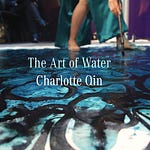Displaying pictures of plants, soil and earthworks being drawn on a see-through whiteboard, accompanied with clear and articulate explanations, Andrew Millison’s water and permaculture videos have reached millions of viewers on Youtube, making Andrew one of the most well known permaculture teachers in the world today.
Beginning in the desert like conditions of Arizona, Andrew learnt the ways of water wizardry with permaculture teachers like water pioneer Brad Lancaster, before heading to the more lush Oregon. There, a student organized to get him on the faculty at Oregon State University, whereby he soon found himself a Senior Instructor, teaching various permaculture courses, including a permaculture MOOC (Massive Open Online Courses) that was taken by many.
Andrew’s artfully made permaculture videos were put by the university online. To his surprise, one of his videos, on permaculture principles, got a hundred thousand views (later the video would even reach 700,000 views). He could see this modality was a way to reach a larger scale audience - ‘this was a real leverage, people were commenting from all over the world’. So he pivoted to focusing more on videos.
In 2017, he flew out to India for the International Permaculture conference, and afterwards embarked on a two month pilgrimage to look at water systems there. He studied the craft of videography, then flew back out in 2019-2020, to shed light on what he calls the world’s biggest permaculture project, filming a series of videos titled “India’s Water Revolution”.
The videos have now gotten millions of hits on Youtube, and inspired people from other countries to replicate the Indian watershed restoration projects. I remember stumbling across these videos awhile back, and being blown away by the scale and success of what was happening in India.
…
Unlike in the US with its winter rains, the monsoon comes in the summer in India. In the state of Mahrastra, as the month of June approaches, the hot air becomes pregnant with humidity. Wild and powerful winds, blowing in from the oceans southeast, will then, over the course of the next few months, dump its rains on the lands.
To Indians the rains mean creativity and a source of new beginnings. They have gods to the rain. They play in the rain. Rain infuses into their politics and their education system.
India is a land of 1.4 billion people where two thirds of them live rurally. In Maharastra, heavily dependent on agriculture, the rains are a measure of success for the community and for the economy. When the droughts hit Maharastra, the effects were devastating. Fights broke out at community wells, farmers committed suicide, and villagers, unable to support themselves, moved to the big cities.
The Paani Foundation, an organization that included the Bollywood star Aamir Khan, set out to see what they could do about the water crisis. They discovered that one village, Hiware Bazar, had succeeded during these times, continuing to produce bountiful food and vegetation within a thriving watershed. The village, covering an area of about two thousand plus acres, has forested slopes, ponds, and contour trenches which caught the rain during monsoon season to store it for the dry season. There was measurably more rain falling on their village than on neighboring villages.
In other parts of Maharashtra, overgrazing of the land, and misguided attempts by villagers to cut down trees - because they thought it robbed the fields of fertilizer - had left the land unable to absorb the monsoon rains.
The Paani Foundation decided to spread the ways of Hiware Bazar to other villages in Maharastra.
Explaining earthworks, a way of terraforming the land, was key. The villages were taught to dig Continous Contour Trenches, which are similar to the swales of permaculture. They learnt to build check dams with rocks, which would slow and redirect the monsoon rains as it flowed down the landscape. Some of the rainwater would be funneled to ponds with liners that stored the water so that it could be used during dry season. Rainwater would also be funneled to ponds without liners so that it would seep down to fill the aquifers. The water table would rise to give the villagers more well water. Summer monsoon water was transferred across time, aided by villager built earthworks and rising aquifers, to provide for the village in the rain-scarce months.
Replanting trees and growing soil in these villages would also be key to slowing, sinking, and spreading the stormwaters so that it could hydrate the landscape.
The Paani Foundation organized a Water Cup competition between the villages to see who could improve their watershed the most, and over 8000 villages participated. The results were astonishing. Landscapes were transformed, crops flourished, and the drain of people to the big cities was lessened.
In the Pemgiri area in Maharashtra, where there are many villages, each with a size of about 2000 acres each, those areas that had trees and greenery, had noticeably more rain, than those areas which remained denuded.
Rajendra Singh, who comes by the cool moniker, Water Man of India, has said that in areas with mountains or plateaus to partially block the wind, an area of 600-2000 acres is enough to create more rain. In flat areas one needs about 60 square kilometers to start generating rain.
After four years of success with the Water Cup, the Paani Foundation has now organized a Farmers Cup, where villages are taught how to grow rich soil and healthy plants. Its a friendly competition to see who can grow the best organically.
This is a story of a communal water methodology in a village - Hiware Bazar, that became a state-wide movement - in Maharashtra, that became known around the world - through Andrew Millison’s videos. Maybe it can become a world-wide movement. Maybe some of you can help.
Time stamps for podcast:
1:10 Learning about water Arizona. Curb cut idea of Brad Lancaster
6:15 Teaching permaculture and water at Oregon State University. The launch of his videos.
16:50 India and water
30:25 How revegetation and restoring watersheds has increased the rain in those watersheds in India
47:00 water situation in Africa
49:20 water situation in USA
53:57 dampening extreme weather through restoration of the land. Shock absorbers do lessen extreme flooding and drought.
56:10 On integrating climate movement and permaculture
……………………..
This is a reader supported publication














Share this post